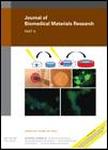版权所有:内蒙古大学图书馆 技术提供:维普资讯• 智图
内蒙古自治区呼和浩特市赛罕区大学西街235号 邮编: 010021

作者机构:Emory Univ Dept Otolaryngol Atlanta GA 30322 USA Emory Univ Dept Pediat Atlanta GA 30322 USA Emory Univ Wallace H Coulter Dept Biomed Engn Atlanta GA 30322 USA Georgia Inst Technol Atlanta GA 30332 USA Georgia Inst Technol Petit Inst Bioengn & Biosci Atlanta GA 30332 USA
出 版 物:《JOURNAL OF BIOMEDICAL MATERIALS RESEARCH PART A》 (生物医学材料研究杂志)
年 卷 期:2018年第106卷第2期
页 面:552-560页
核心收录:
学科分类:0831[工学-生物医学工程(可授工学、理学、医学学位)] 1001[医学-基础医学(可授医学、理学学位)] 0805[工学-材料科学与工程(可授工学、理学学位)] 10[医学]
基 金:Oral Maxillofacial Surgery Foundation Children's Healthcare of Atlanta Research Trust NIH [HL127236]
主 题:JAGGED1 notch bone hydrogel
摘 要:Osteoblast commitment and differentiation are controlled by multiple growth factors including members of the Notch signaling pathway. JAGGED1 is a cell surface ligand of the Notch pathway that is necessary for murine bone formation. The delivery of JAGGED1 to induce bone formation is complicated by its need to be presented in a bound form to allow for proper Notch receptor signaling. In this study, we investigate whether the sustained release of JAGGED1 stimulates human mesenchymal cells to commit to osteoblast cell fate using polyethylene glycol malemeide (PEG-MAL) hydrogel delivery system. Our data demonstrated that PEG-MAL hydrogel constructs are stable in culture for at least three weeks and maintain human mesenchymal cell viability with little cytotoxicity in vitro. JAGGED1 loaded on PEG-MAL hydrogel (JAGGED1-PEG-MAL) showed continuous release from the gel for up to three weeks, with induction of Notch signaling using a CHO cell line with a Notch1 reporter construct, and qPCR gene expression analysis in vitro. Importantly, JAGGED1-PEG-MAL hydrogel induced mesenchymal cells towards osteogenic differentiation based on increased Alkaline phosphatase activity and osteoblast genes expression including RUNX2, ALP, COL1, and BSP. These results thus indicated that JAGGED1 delivery in vitro using PEG-MAL hydrogel induced osteoblast commitment, suggesting that this may be a viable in vivo approach to bone regeneration. (c) 2017 Wiley Periodicals, Inc. J Biomed Mater Res Part A: 106A: 552-560, 2018.